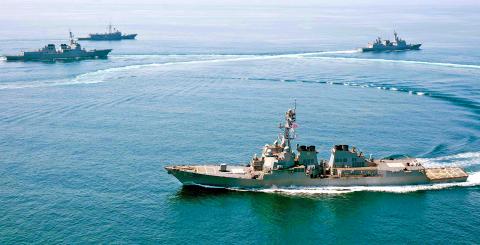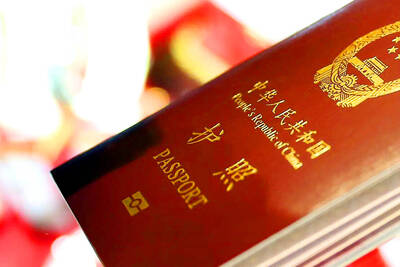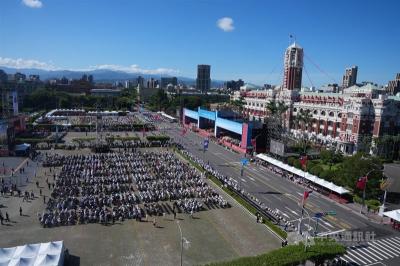The US yesterday defied China by sending a warship close to artificial islands China is building in disputed waters, prompting Beijing to furiously denounce what it called a threat to its sovereignty.
The USS Lassen passed within 12 nautical miles (22.2km) — the normal limit of territorial waters around natural land — of at least one of the formations Beijing claims in the South China Sea.
Chinese authorities “monitored, shadowed and warned” the guided-missile destroyer in the Spratly islands (Nansha Islands, 南沙群島) — which Taiwan, Malaysia, the Philippines, Vietnam and Brunei also state claims to — Beijing said.

Photo: EPA
Washington’s long-awaited move to assert freedom of navigation might escalate the dispute over the strategically vital waters, where Beijing has been transforming reefs and outcrops into artificial islands with potential military use.
China claims sovereignty over almost the whole of the area, raising concerns it could one day seek to dictate who might transit its bustling sea lanes.
The dispute has raised fears of clashes in an area through which one-third of the world’s oil passes.

Photo: Reuters
The US action was part of the nation’s “routine operations in the South China Sea in accordance with international law,” a US official said.
“We will fly, sail and operate anywhere in the world that international law allows,” he added.
Chinese Ministry of Foreign Affairs spokesman Lu Kang (陸慷) blasted the exercise, saying the ship had “illegally entered” the waters near the islands “without receiving permission from the Chinese government.”

Photo: CNA
Beijing “resolutely opposes any country using freedom of navigation and overflight as a pretext for harming China’s national sovereignty and security interests,” he said, adding: “[China will] staunchly defend its territorial sovereignty.”
China’s Xinhua news agency condemned a “flagrant and baseless provocation” that added to regional instability.
However, despite the Chinese rhetoric, analysts said more such operations could be expected.
Beijing’s so far limited response showed that it had had “its bluff called,” said Rory Medcalf, director of the International Security Program at the Lowy Institute in Sydney.
“The US, and its allies and partners, should now help the Chinese leadership in saving face, by emphasizing that freedom of navigation operations are normal, not extraordinary,” he said.
There have been repeated confrontations in the area between Chinese vessels and boats from some of its neighbors who assert rights to the waters, particularly the Philippines and Vietnam.
Both are members of ASEAN, which has long called on China to negotiate a code of conduct in the region, as are fellow claimants Brunei and Malaysia. Taiwan also states claims over part of the sea.
Manila has infuriated the world’s second-largest economy by taking the dispute to a UN tribunal, and Philippine President Benigno Aquino III said the US action demonstrated that “the balance of power says that there is not just a single voice that must be adhered to.”
Beijing’s South China Sea reclamations have been seen as an attempt to assert its claims by establishing physical facts in the water, but Aquino said: “There is no de facto changing of the reality on the ground.”
Beijing has repeatedly said the construction work is primarily for civilian purposes, and Chinese President Xi Jinping (習近平), during a visit to Washington last month, pledged that the nation would not militarize the area.
However, satellite images of the islands published by the Washington-based Center for Strategic and International Studies (CSIS) show that Beijing has reclaimed millions of square meters of land in the Spratlys.
The pictures also show a host of facilities with the potential for military applications being developed, including as many as three runways, at least one of them 3,000m long.
The US, which is engaged in a foreign policy “pivot” to Asia, and China, which has the world’s largest military and is expanding the reach of its navy, are jockeying for position in the Pacific region.
Beijing regularly calls for a “new model of major country relations,” implying equality between the world’s top two economic and military powers.
The US’ operations yesterday were “not directed at any specific country,” the US official said.
“US forces operate in the Asia-Pacific region on a daily basis, including in the South China Sea,” he added.
The sail-by was “long overdue,” said Bonnie Glaser, a senior China expert at CSIS, adding that the exercises “should be done quietly, regularly and often.”
“There should be no media fanfare,” she said.
“The way this has been handled has left the Chinese believing that the US is challenging its sovereignty, rather than simply exercising freedom of the seas,” she added.
Later yesterday, Chinese Vice Minister of Foreign Affairs Zhang Yesui (張業遂) summoned US ambassador to China Max Baucus. Zhang called the US patrol “extremely irresponsible” and urged the US to cease actions that harm China’s sovereignty and security interests, China Central Television reported.

The Ministry of the Interior (MOI) is to tighten rules for candidates running for public office, requiring them to declare that they do not hold a Chinese household registration or passport, and that they possess no other foreign citizenship. The requirement was set out in a draft amendment to the Enforcement Rules of the Public Officials Election and Recall Act (公職人員選舉罷免法 ) released by the ministry on Thursday. Under the proposal, candidates would need to make the declaration when submitting their registration forms, which would be published in the official election bulletin. The move follows the removal of several elected officials who were

The Republic of China (ROC) is celebrating its 114th Double Ten National Day today, featuring military parades and a variety of performances and speeches in front of the Presidential Office in Taipei. The Taiwan Taiko Association opened the celebrations with a 100-drummer performance, including young percussionists. As per tradition, an air force Mirage 2000 fighter jet flew over the Presidential Office as a part of the performance. The Honor Guards of the ROC and its marching band also heralded in a military parade. Students from Taichung's Shin Min High School then followed with a colorful performance using floral imagery to represent Taiwan's alternate name

COVETED PRIZE: The US president would be a peace prize laureate should he persuade Xi Jinping to abandon military aggression against Taiwan, William Lai said US President Donald Trump should get the Nobel Peace Prize should he be able to convince Chinese President Xi Jinping (習近平) to abandon the use of force against Taiwan, President William Lai (賴清德) told a conservative US radio show and podcast in an interview. The US is Taiwan’s most important international backer, despite the absence of formal ties, but since Trump took office earlier this year he has not announced any new arms sales to the nation. Trump could meet Xi at the APEC summit in South Korea on Oct. 31 and Nov. 1. Lai, speaking on The Clay Travis and Buck Sexton

A Chinese takeover of Taiwan would severely threaten the national security of the US, Japan, the Philippines and other nations, while global economic losses could reach US$10 trillion, National Security Council Deputy Secretary-General Lin Fei-fan (林飛帆) wrote in an article published yesterday in Foreign Affairs. “The future of Taiwan is not merely a regional concern; it is a test of whether the international order can withstand the pressure of authoritarian expansionism,” Lin wrote in the article titled “Taiwan’s Plan for Peace Through Strength — How Investments in Resilience Can Deter Beijing.” Chinese President Xi Jinping’s (習近平) intent to take Taiwan by force